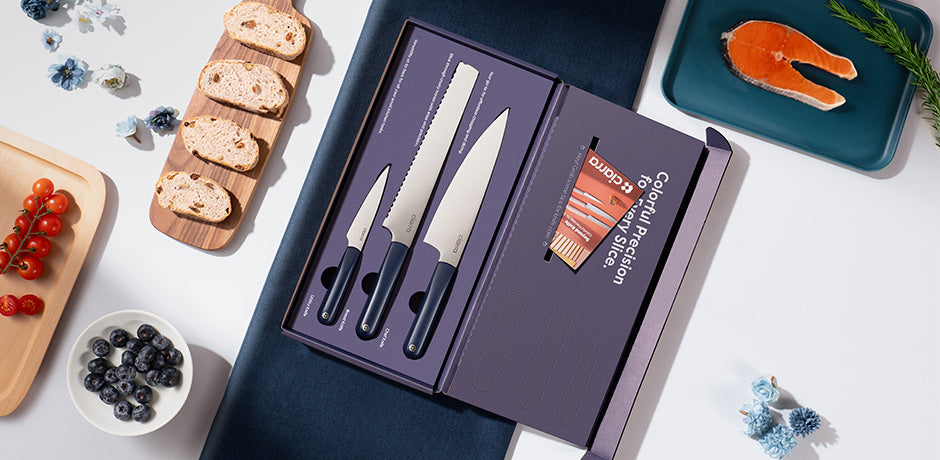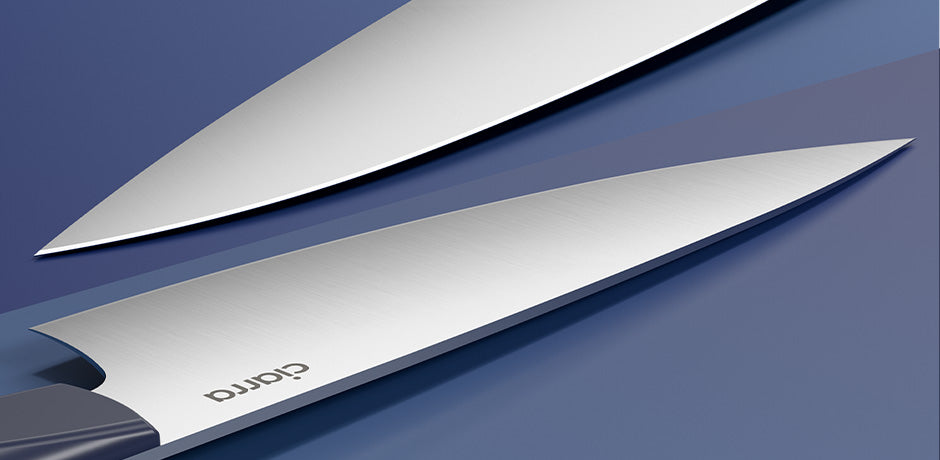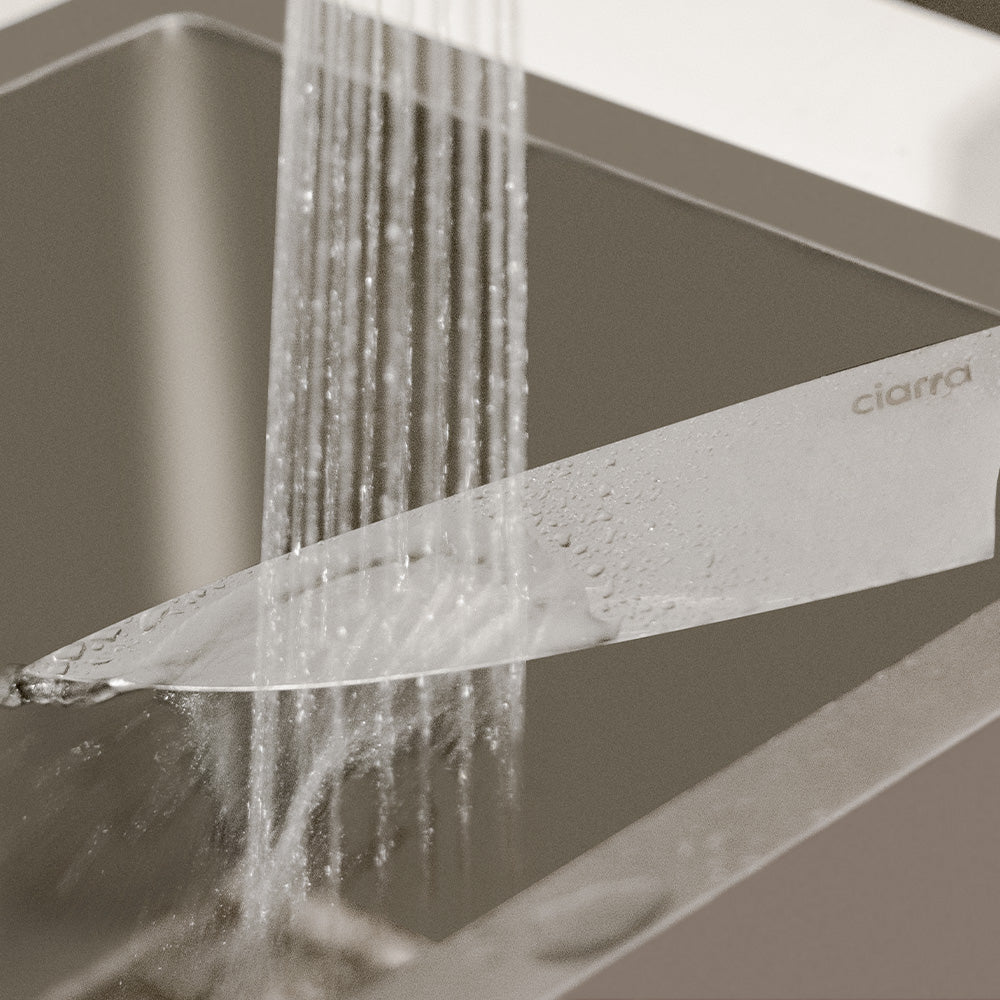If you think having a set of knives is just a luxury, think again. Choosing the right knife is essential for achieving the best results in the kitchen.
The correct knife can save you time, create precise textures, and enhance safety by reducing the risk of injury. Using the wrong knife, on the other hand, can damage both the food and the user. It's no wonder most professional chefs agree that quality knives are the most critical tools in any kitchen.
However, purchasing a knife is just the beginning. Learning how to use each knife properly is just as important. Professional chefs spend years mastering their skills and gaining confidence with a wide range of kitchen tasks. As with most things in life, practice makes perfect. 
What is a Chef's Knife?
A chef's knife is a versatile and essential tool in any kitchen, prized for its multifunctionality and precision. It typically features a broad, sharp blade that tapers to a fine point, making it suitable for a wide range of tasks such as chopping, slicing, dicing, and mincing. Originally designed for slicing and disjointing large cuts of meat, the chef's knife has evolved to become an all-purpose kitchen staple.
Chef’s Knife features
Originated in Germany and France
Broad blade that curves upwards to form a tip (spine is thicker to add weight)
Comes in serrated varieties
Usually only found in double bevel
Has a bolster
Heavier to hold
May feature a granton edge
Varies in size from 6” to 12” (8” is most popular but many professionals opt for 10” or 12”)

What is Commonly Called as Chef's Knife?
A chef's knife is often referred to as a "cook's knife." Both terms are used interchangeably and describe the same type of knife. The name "cook's knife" underscores its utility for anyone preparing meals, whether a professional chef or a home cook.
Chef's Knife vs Santoku Knife
Santoku Knife
- Origin: Japan
- Features a wide, sheepsfoot blade with no tip; the spine curves down to meet the straight-edged blade.
- Thinner blade compared to a Chef’s Knife, ideal for refined slicing.
- Can have a single (one-sided) or double (two-sided) bevel. A bevel refers to the surface ground to form the knife's edge.
- Typically lacks a bolster (the metal piece between the blade and handle).
- Balanced weight and lighter to hold.
- May include a granton edge (scalloped divots to prevent food from sticking).
Sizes range from 5” to 7.9”.
Chef’s Knife
- Origin: Germany and France
- Broad blade with a curved edge that forms a tip; the spine is thicker to add weight.
- Available in serrated varieties.
- Typically has a double bevel.
- Includes a bolster.
- Heavier and sturdier to hold.
- May also feature a granton edge.
- Sizes range from 6” to 12” (8” is the most popular, though professionals often prefer 10” or 12”).
While both knives serve general-purpose cutting tasks, their distinctions lie in their origins and blade designs, which influence their cutting styles. Santoku knives, made with thinner and harder Japanese steel (e.g., Honshu Steel), excel in precision tasks. In contrast, Chef’s knives, with their thicker, curved blades, are better suited for heavier-duty cutting and rocking motions.

What is a Chef's Knife Used For?
1. Chopping and Dicing
Ideal for cutting vegetables, fruits, and herbs into small, uniform pieces. The curved blade allows for a rocking motion, making chopping quick and efficient.
2. Slicing
Perfect for slicing meat, poultry, and fish into clean, even portions.
Can handle everything from delicate cuts of salmon to thick steak slices.
3. Mincing
Excellent for finely chopping garlic, onions, and herbs into tiny pieces.
The curved blade edge makes repetitive motions easy for precision work.
4. Breaking Down Large Ingredients
Strong enough to cut through larger ingredients like squash, melons, or root vegetables.
The weight and heft of the knife provide stability and power.
5. Crushing
The flat side of the blade can be used to crush garlic cloves or ginger.
Specialized Uses
6. Carving
While not as specialized as a carving knife, a Chef’s knife can be used to carve cooked meats like chicken or turkey.
7. Transferring Ingredients
The broad blade makes it easy to scoop and transfer chopped ingredients to a bowl or pan.
8. Cutting Through Small Bones or Cartilage
The sturdy spine and weight can handle smaller bones, though heavier cleavers are better for larger ones.
Why Choose a Chef’s Knife?
Its versatility, durability, and ergonomic design make it an indispensable tool for both professional chefs and home cooks. While it excels in many tasks, specialized knives may be better suited for precision work like filleting fish or peeling. However, the Chef’s knife remains a kitchen workhorse for everyday use.
Craftsmanship Matters
When selecting a chef’s knife, it’s crucial to consider the craftsmanship. A well-crafted knife not only enhances performance but also ensures longevity and ease of maintenance.
Forged vs. Stamped Knives
Understanding how a knife is made is key to building your collection. There are two primary manufacturing methods:
-
Forged Knives: Crafted from a single piece of metal, forged knives are known for their durability, weight, and balance. They often feature a bolster for added control and are typically more expensive due to their superior quality.
-
Stamped Knives: These are cut from a large sheet of metal and are lighter and more affordable than forged knives. However, they may lack the balance and durability of their forged counterparts.
Blade Types
Selecting the right blade material can significantly impact performance and maintenance. Here are the most common options:
Stainless Steel
- Pros: Affordable, rust-resistant, and low-maintenance.
- Cons: Does not retain sharpness as well as other materials and can be harder to resharpen.
High Carbon Stainless Steel Knife
- Pros: Combines sharpness, edge retention, rust resistance, and easy resharpening.
- Cons: Slightly more expensive but highly popular among professionals for its balanced qualities.
Carbon Steel Knife
- Pros: Exceptional sharpness and edge retention. Easy to resharpen.
- Cons: Requires frequent maintenance to prevent rust and staining, which can be a drawback for some users.
Ceramic Knife
- Pros: Ultra-sharp, lightweight, and retains its edge longer than metal blades.
- Cons: Fragile—can shatter if dropped or mishandled.
Maintaining Your Knife Collection
Sharpening Knives
A knife is only as effective as its condition, so to keep them safe to work with and at their best, they need to be sharpened and honed regularly.
You may opt to use a steel to hone a Chef’s Knife in between bouts of sharpening. If so, what follows are some general steps in using a honing steel. It does take practice so take your time at the start. Remember to always refer to the steel’s manufacturer instructions too.
- Hold the knife’s handle in your dominant hand and the steel in the other, both pointing upright. Meet them together in a V-shape.
- Position the blade’s heel against the steel around 2cm from the top of the steel.
- Ensure you have the right angle (approximately 15 – 20 degrees).
- Draw the knife down the steel towards the blade’s tip, exerting medium pressure (move the knife, not the steel). Ensure only the edge touches the steel, not the side. Do this 5 to 10 times. Try to maintain consistency in terms of the angle. This is more important than speed. Repeat on other side of the blade.
Storing Knives
There are several ways to store your knives to both preserve them and keep them safely out of the way.
- Knife blocks,
- Wood or lined storage trays,
- Magnetic knife holders, (particularly useful when space is tight),
- A knife bag, good for on-the-go chefs.
Cleaning Your Knives
Comprehensive Guide to Proper Cleaning of Knives
- Handle Care: Ensure the handle is also cleaned, as it can harbor bacteria.
- Avoid Harsh Cleaners: Acidic or abrasive cleaners can damage the blade and compromise its integrity.
- Avoid Dishwashers: Handwashing is recommended, as dishwashers can lead to blade damage and exposure to harsh detergents.
Tips For Removing Tough Stains, Odors, And Residue From Knives
- Lemon Juice: Effective for removing stains and odors. Apply and let it sit for a few minutes before rinsing.
- Baking Soda Paste: Create a paste with baking soda and water to tackle stubborn stains. Apply, scrub, and rinse.

FAQs
How Long Can a Kitchen Knife be Wet?
It's best not to leave a kitchen knife wet for long periods of time. The longer your knife spends wet, the more prone it will be to rusting. Try to avoid exposing your knife to water for periods of longer than 2-3 minutes.Ideally, after using the knife, dry it off immediately to prevent any potential damage to the blade or handle.
How to Get Rust Off a Knife?
If a knife has developed rust, here's how to remove it:
Use a rust eraser or abrasive pad: Special rust erasers (often made of rubber) can be gently rubbed over the rusty areas. Alternatively, a fine steel wool or abrasive pad can be used for more stubborn rust.
Baking soda paste: Make a paste with baking soda and water, apply it to the rust, and let it sit for about 15–20 minutes. Then, scrub the rust off with a soft brush or sponge.
Oil or WD-40: For minor surface rust, you can apply a little mineral oil or WD-40 to the rusted area. Let it sit for a bit, then scrub gently with a non-abrasive cloth or sponge.
After removing rust, ensure the knife is thoroughly dried and oiled to prevent further rusting.
When Must a Knife be Cleaned and Sanitized?
The golden rule of knife hygiene is to clean and sanitize them after every use. Whether you're slicing, dicing, or chopping, this ensures that any residue is quickly removed, reducing the risk of cross-contamination.

